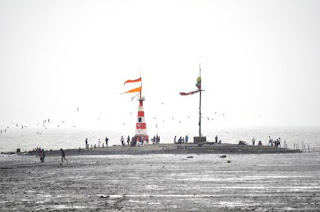Introduction
Have you heard of an undersea temple in India? It is very much there in Bhavnagar district of Western Indian state of Gujarat. The temple in question is situated off the coast of a village called Koliyak. At this village, the people reach out to Lord Shiva temple about 1.5 kilometers into the sea. This place of worship is known as Nishkalank Mahadev temple. The devotees cannot visit most of the time throughout the day. There are fixed timings for that. Despite this restriction, thousands throng this temple to offer their prayers to the presiding deity. In this blog post, we will look at this wonderful temple and the mythology associated with this undersea temple for the benefit of our inquisitive readers.
Undersea Temple
Located off the coast of the village Koliyak in Bhavnagar district of Gujarat is the famous underwater Shiva temple that is thousands of years old. It is known as Nishkalank Mahadev temple. It is situated about 1.5 kilometers in the Arabian Sea. As the name of the temple suggests, it is expected to cleanse and purify the soul of the devotees who worship the presiding deity in obeisance. The older generation people say the sight of Lord Shiva at this temple washes their guilt off. There is a peculiarity about this temple. It is situated in the Arabian Sea, about 1.5 kilometers off the coast of the village Koliyak. On a heavy tide day, sitting on the coast, all the people can see are flag and pillars. One can visit this temple only two times in a day. The temple becomes only accessible only when there is a low tide. The temple is visible only during the high- and low-tide periods during the course of the day. Due to this reason, the temple is accessible only for few hours for the people. During Full Moon and New Moon days, the sea recedes to the maximum levels when the Sun, Moon and the Earth are in straight line alignment. Hence, people throng this temple to the maximum during these days.
Features of the Temple
This temple is about 2000 feet long and 500 feet high. Five distinct Swaymbhu Shivalingams can be seen inside the temple. These lingams are spread across a square platform. Before each lingam, the devotees can see the Nandhi or Bull, the vehicle of Lord Shiva. They can even see a pond in the premises of the temple. There is a guest house for the people coming from different locations. This guest house has been named as Dharamshala. Since it is inside the sea most of the time, there are no facilities for food and treatment.
Legends and Activities of the Temple
Legends say this temple pond was used by Pandavas to wash their hands after their epic war with the evil cousins, the Kauravas. The legends further add that with this act, Pandavas had washed their sins off. This is the reason why devotees first wash their hands and legs before entering the temple. On New Moon day, the people assemble at this temple in large numbers as it is considered as an auspicious day. It falls in the month of August every year. This month corresponds to Bhadra of Hindu calendar year. On this day, the sea recedes maximum. Aartis of the deities take place at 6:30 AM in the morning and 7:00 PM in the evening every day. This is the reason why many people come to this temple to dissolve ashes of their departed kith and kin.
Video Grab
For visual narration and first-hand information, the readers are welcome to go the under-given video link and click it. It will also give more elaborate information about this natural wonder and its mythological significance in Hinduism. This video also takes into account the local legends about this beautiful temple. While clicking, please mention "Har Har Mahadev!"






 k+
k+


0 Post a Comment:
Post a Comment